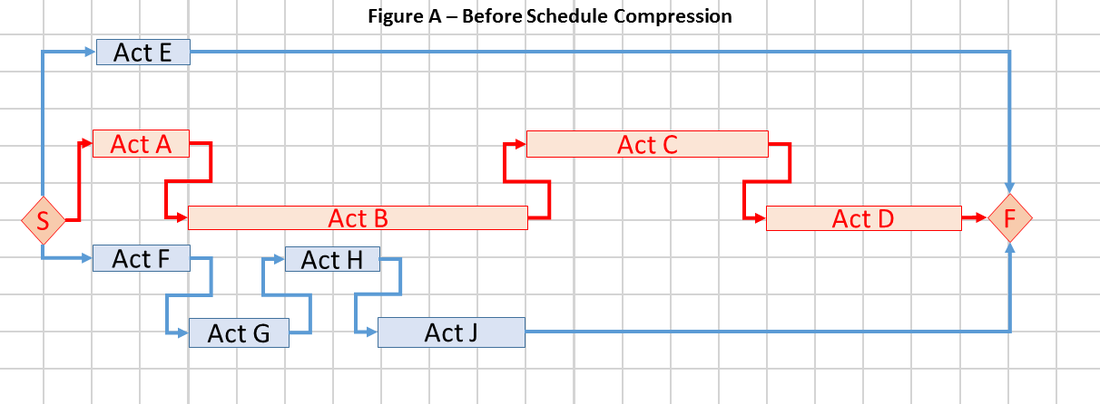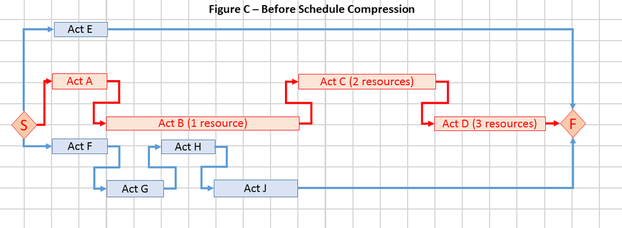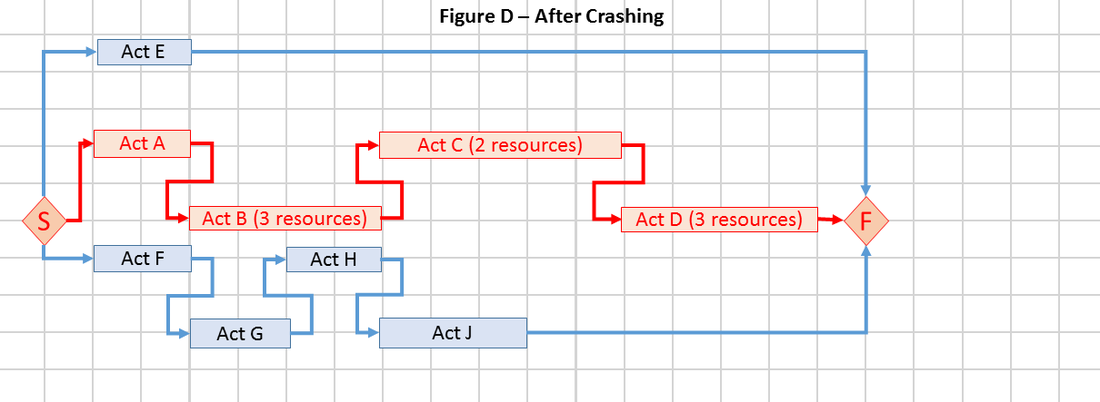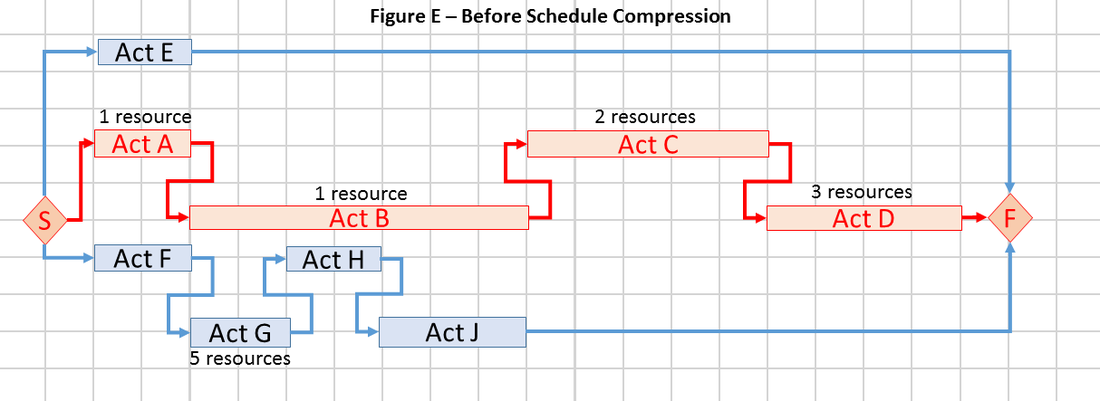The objective of this presentation is to discuss the compressing of a project’s schedule in as simple and easy a way as possible.
What is schedule compression?
Whenever we find ourselves with a project schedule that indicates that the estimated project finish date is later than the finish date required by the project stakeholders we need to find ways to compress the schedule. In other words we need to find ways to be able to complete the project within the required time frame. There are numerous ways or strategies that can be followed to do this, of which the most commonly used techniques are:
What is fast tracking?
Fast tracking is a schedule compression technique where we change the logic of the project schedule by overlapping critical activities rather than working them strictly in sequence. For instance, if we have a project scheduled as follows:
What is schedule compression?
Whenever we find ourselves with a project schedule that indicates that the estimated project finish date is later than the finish date required by the project stakeholders we need to find ways to compress the schedule. In other words we need to find ways to be able to complete the project within the required time frame. There are numerous ways or strategies that can be followed to do this, of which the most commonly used techniques are:
- Fast tracking.
- Crashing.
- Resource reallocation.
What is fast tracking?
Fast tracking is a schedule compression technique where we change the logic of the project schedule by overlapping critical activities rather than working them strictly in sequence. For instance, if we have a project scheduled as follows:
According to the schedule it will take 18 days to complete this project. If it was a requirement that the project must be completed within 15 days then we should find a way to compress the schedule from 18 to 15 days – that means we must somehow save 3 days.
Fast tracking is a technique where we run two or more activities concurrently and not in sequence as currently scheduled. There are some aspects that need to be kept in mind such as:
In the example schedule above the best candidates for fast tracking would therefore be activities A, B, C and D. Some of the possible scenarios could include:
The most important aspect that should be kept in mind is that fast tracking can introduce more risk into the project. If the project was originally scheduled in such a way that activity B cannot or should not start before activity A is completed, then it is safe to assume that there must have been a very good reason for this to be the case. For instance if activity A is the unloading and safeguarding of the rifle on the shooting range and activity B is handing it back to the shooting instructor I am sure you will appreciate the risk if you are the shooting instructor and I am attempting to do both activities at the same time!
The bottom line is fast tracking should only be done if the risk introduced by changing the order in which activities are executed, can be managed.
Fast tracking is a technique where we run two or more activities concurrently and not in sequence as currently scheduled. There are some aspects that need to be kept in mind such as:
- In order to shorten the project (to save the 3 days of the duration) we will have to shorten the longest string of activities, called the critical path (indicated in red). That means that two or more activities on the critical path will have to be overlapped.
- Activities selected for fast tracking should have a duration longer than the number of days that is required to shorten the schedule. It will not be sufficient to run two activities, one with a duration of two days, concurrently and hope to save three days off the schedule. The most that the schedule can be shortened will be two days and therefore another or an additional activity should be selected for compression.
- Care should be taken if the activities selected for fast tracking share the same resources. If it is the same resource working on both activities then that resources may become scheduled to work more hours than what is humanly possible for the period of the overlap.
In the example schedule above the best candidates for fast tracking would therefore be activities A, B, C and D. Some of the possible scenarios could include:
- Executing activity A and activity B concurrently. That will save a maximum of two days.
- Executing activity B and activity C at the same time. That will save a maximum of five days.
- Executing activity C and activity D simultaneously. That will save a maximum of four days.
- Overlapping activity A and activity B with one day, activity B and activity C with one day and activity C and activity D with one day.
The most important aspect that should be kept in mind is that fast tracking can introduce more risk into the project. If the project was originally scheduled in such a way that activity B cannot or should not start before activity A is completed, then it is safe to assume that there must have been a very good reason for this to be the case. For instance if activity A is the unloading and safeguarding of the rifle on the shooting range and activity B is handing it back to the shooting instructor I am sure you will appreciate the risk if you are the shooting instructor and I am attempting to do both activities at the same time!
The bottom line is fast tracking should only be done if the risk introduced by changing the order in which activities are executed, can be managed.
Above is an example of the same project fast tracked by overlapping activity B and activity C by three days. The project is now scheduled to be completed in 15 and no longer in 18 days. Bear in mind this is only valid if:
What is crashing?
Crashing is a technique used to shorten the estimated schedule duration for the least incremental cost by adding more resources. Crashing works only for activities on the critical path where additional resources will shorten the activity’s duration. Bear in mind that not all activities can be completed in a shorter timeframe if more resources are added. Activities where a lot of communication and creativity is involved (for instance creating the WBS) will most probably take longer if more resources are added. On the other hand some activities are excellent candidates for crashing for instance an activity where one labourer is scheduled to dig a trench of 100 meter long in four days. Using 2 labourers could possible shorten this activity to 3 days. Using 4 labourers could possibly bring it down to 2 days etc.
Care should be taken when estimating what impact the adding of resources on the duration will have as it is not just a mathematical calculation where we can assume by doubling the number of resources we will halve the duration. The measure of compression can for example be impacted by:
Let’s look at an example of a project estimated to take 18 days to complete:
- The nature of activities A and B are such that the overlap is physically possible.
- The risk can be managed.
- The overlap is not causing an unmanageable schedule overload for the resources involved.
What is crashing?
Crashing is a technique used to shorten the estimated schedule duration for the least incremental cost by adding more resources. Crashing works only for activities on the critical path where additional resources will shorten the activity’s duration. Bear in mind that not all activities can be completed in a shorter timeframe if more resources are added. Activities where a lot of communication and creativity is involved (for instance creating the WBS) will most probably take longer if more resources are added. On the other hand some activities are excellent candidates for crashing for instance an activity where one labourer is scheduled to dig a trench of 100 meter long in four days. Using 2 labourers could possible shorten this activity to 3 days. Using 4 labourers could possibly bring it down to 2 days etc.
Care should be taken when estimating what impact the adding of resources on the duration will have as it is not just a mathematical calculation where we can assume by doubling the number of resources we will halve the duration. The measure of compression can for example be impacted by:
- Whether the nature of the activity lends it to be compressed by adding more resources.
- The type and number of resources added.
- How much of a learning curve the new resources will have as things can at first get extremely slow before it starts to speed up.
Let’s look at an example of a project estimated to take 18 days to complete:
If in the above example the project needed to be completed in 15 days and we decide to use crashing, how could we do it? When selecting the best activities for crashing we should keep in mind that:
If for instance in the example above, we decide to assign two additional resources to activity B. We also estimate that if there are three resources assigned to activity B then the activity can be completed in 4 days as compared to 7 days if only one resource is assigned. This would mean that we now estimate to complete the project in 15 days as per figure D:
- As with fast tracking, only shortening activities on the critical path will result in compressing the duration of the project.
- Again, the longer the activity the bigger the potential for compressing it.
- The cost vs. duration compression ratio will not be the same for all activities. The objective is to implement the most economical alternative.
If for instance in the example above, we decide to assign two additional resources to activity B. We also estimate that if there are three resources assigned to activity B then the activity can be completed in 4 days as compared to 7 days if only one resource is assigned. This would mean that we now estimate to complete the project in 15 days as per figure D:
The most important aspect to keep in mind with crashing is that it will add to the cost of the project. We can therefore only consider crashing if we will be able to get the additional funds approved. For this reason we aim to do it as cost effective as possible. Looking at the following table it is clear that the most economical alternative would be to crash activity B as the crash cost is only 833 USD per day saved.
What is resource reallocation?
Resource reallocation involves moving resources from non-critical to critical activities with the objective to shorten the critical path. This technique does not change the scheduling logic (such as fast tracking does) nor does it require additional resources to be assigned to the project as is the case with crashing. It is used to shorten the estimated schedule duration by more effective utilization of the existing project resources. Let’s assume that we have a project as schedule in Figure E. We are again faced with the requirement that we must compress the project duration by 3 days. This time we decide to use resource reallocation:
Resource reallocation involves moving resources from non-critical to critical activities with the objective to shorten the critical path. This technique does not change the scheduling logic (such as fast tracking does) nor does it require additional resources to be assigned to the project as is the case with crashing. It is used to shorten the estimated schedule duration by more effective utilization of the existing project resources. Let’s assume that we have a project as schedule in Figure E. We are again faced with the requirement that we must compress the project duration by 3 days. This time we decide to use resource reallocation:
When selecting activities for resource reallocation we should take into consideration:
If in the above example (Figure E) we have decided to move 2 resources from activity G to activity B then the schedule could typically look as follows:
- The activity to which the resources are moved must be on the critical path.
- The activity from which the resources are moved must not be on the critical path.
- The resources moved must be appropriately skilled to complete the activity to which they are reallocated to.
- There may also be a learning curve for them on the new activity.
If in the above example (Figure E) we have decided to move 2 resources from activity G to activity B then the schedule could typically look as follows:
In the above case Activity B is compressed from 7 to 4 days due to 2 additional resources assigned to this critical activity. Activity G will now take 4 and not only 2 days to complete due to two of the resources taken away from this activity. The net result is that the duration of the critical path (and therefore for the project) is reduced from 18 to 15 days. The duration of the non-critical path F, G, H and J is extended with 3 days with the result that the amount of float on this path is reduced from an original of 9 days to 4 days after the resource reallocation.
Any one or a combination of any of these techniques can be used to do schedule compression – keep in mind however that if a second round of compression is required, the first step is always to confirm what the latest critical path is as the previous compression could have created a new critical path.
Any one or a combination of any of these techniques can be used to do schedule compression – keep in mind however that if a second round of compression is required, the first step is always to confirm what the latest critical path is as the previous compression could have created a new critical path.







 RSS Feed
RSS Feed
